Part 1 of a 3 part series on Siena.
Once upon a time and long ago I was in Siena for an afternoon.
I knew then, standing in the Piazza del Campo, that brief hours were not enough. Planning this trip, I wondered if four days would be too long. There was barely time to visit explore this wandering, wonderful, walled city. The Sights of Siena are ancient in age and timeless in what they has to offer.
We stayed at the Athena Hotel, near an entrance to the city on the opposite side from the train station. (I highly recommend this hotel on every level.) The amazing taxi drivers navigate narrow streets jolting up and down, turning in ways that Pittsburgh natives are comfortable with.
The hotel is within easy walking distance of the city center—the Duomo or the Piazza del Campo. Siena is not for the faint of heart when it comes to walking. Be prepared for lots of hills and multiple steps. (There are many accommodations made for wheelchair access!) The elderly residing in the city have been walking these streets their whole lives and nearly put us to shame.
The sights are many—look around, down and up.
The Cathedral of Santa Maria Assunta
There is the Duomo, striking with green and white stripes versus Siena’s various shades of Tuscan orange. The Duomo is almost too much. Too many people not paying attention to the fact that they are in a church. One of the docents repeated, Silenceo and Silence, but he wasn’t heard.
We took a self-guided tour of the Duomo complex:
- A museum
- tight circular stairs to the first level of the unfinished “new duomo”
- Baptistry of San Giovanni
- library
- Crypt
- and of course the Cathedral.
Buy tickets the day before and start at 10:30 when they open—spend E3 on the “Siena Cathedral” guide. It’s small but details the architecture of what you will walk through.
Of all that, the view of the city from the height of the new duomo terrace was impressive and the Crypt was fascinating. It was constructed in the 13th century, but not discovered until 1999! Isn’t it wonderful that something in the middle of an active city can be hidden for centuries?
Door Knockers
We wound up with over fifty pictures of door knockers. I can’t help it—this is such a novel idea for an American with a boring doorbell. There were some repeats, but not many. They range from scary faces to Egyptian images. A waitress in Bologna told us rich people had frightening knockers to keep the peasants from bothering them. The fierce faces were meant to keep them at bay.
Sights of Siena – Churches
Don’t miss the Basilica di San Francesco, where we accidentally took pictures—missing the no photo sign. It is a captivating place. It is large and empty and peaceful and overwhelming in entirely different ways. I could have lingered longer, visiting each apse, altar, and nook to examine and pray before each painting or sculpture.
I light candles in the tiny churches more than in those well visited. My offering is made, I light the flame, and say my prayers in order. My Mother is first because she would have liked the idea of non-Catholic-me lighting a candle for her. Next is my Dad, followed by cousin Davey, then Uncle Jim and Uncle Jim. Then, everyone else I have lost too soon. I miss them and therefore, they went too soon.
Seeing Siena Properly Takes Preparation
Read about Siena ahead of time and think about the age of everything. The Piazza del Campo was completed in the 1340s. Is it not astonishing that the bricks are still in place, walked upon daily, ridden upon in the Palio each summer?
Stepping into the Piazza del Campo, you have to stop and let the vastness of this seep into you. If you have not been overwhelmed by the bricks making up the entirety of Siena, seeing the oyster-shell layout of the piazza will do the trick. Its nine separate sections of handmade bricks laid in herringbone pattern will amaze you if you truly see it.
With a fifth day in our itinerary, we could have seen the still-unnamed (if anyone knows, please comment) outside the city walls, beautiful one fog-encasing morning; toured the former hospital, the Santa Maria della Scala; or seen the Palazzo Chigi-Saracini with its glowing concert hall.
Meandering Versus Guides
I’m glad that on Wednesday we meandered across the city to see the Fortress of Santa Barbara rebuilt by the de’Medici’s in 1555. There was a vast outdoor market surrounding at least half the fort walls. This is a usual shopping area for the locals, and a delightful surprise for a tourist. There is one permanent cafe casually off to the side where we drank espresso and cappuccino for only E2.50. Who needs Starbucks?
Although my Footprint Guide, “Siena & the Heart of Tuscany” was helpful, I wish I’d left it at home and instead brought the Thames & Hudson World of Art book, “Sienese Painting.” There are paintings and frescos everywhere. They are tucked into cemetery alcoves and on most walls and ceilings throughout the Museo Civico. That museum visit lasted a long time and was well worth the ticket price. We didn’t bother with pre-buying, but I recommend going early before the crowds develop.
Another helpful book is simply called, “Siena, New Practical Guide.” You can pick one up at almost any newsstand or little store. This is the book I used daily. It’s concise, has pictures and highlights the key things to see and do.
Embrace the Evening Sights of Siena
Walking Siena at night is relaxing. So many tour buses come during the day that the throngs of busy tourists zipping in and around you can overwhelm. At night, they’re gone and Siena becomes a different city. It is quiet, serene, open and welcoming to those who want to share her beauty. The Tower Mangia is stunning, jolting up in the dark night sky. That darkness is a canvas showing off the buildings in a whole different way.
Other things to note: this is a living, breathing city. People live behind those knocker-covered doors and conduct business in those buildings (including the one so striking we thought it was a museum, but the guard—without laughing—told us it was a bank!). The streets are off limits to tourist cars—thank goodness—but that doesn’t mean you won’t be startled by the number of them making their way through the throngs of people and negotiating the skinny alleys. The vespas and motorcycles speed by with a hurry—hurry attitude that the Italians really don’t have.
It is an approach to life I’d like to emulate, but maybe that’s impossible living in a city only a few hundred years old.
**
Read: Siena, the Food and Siena, the People
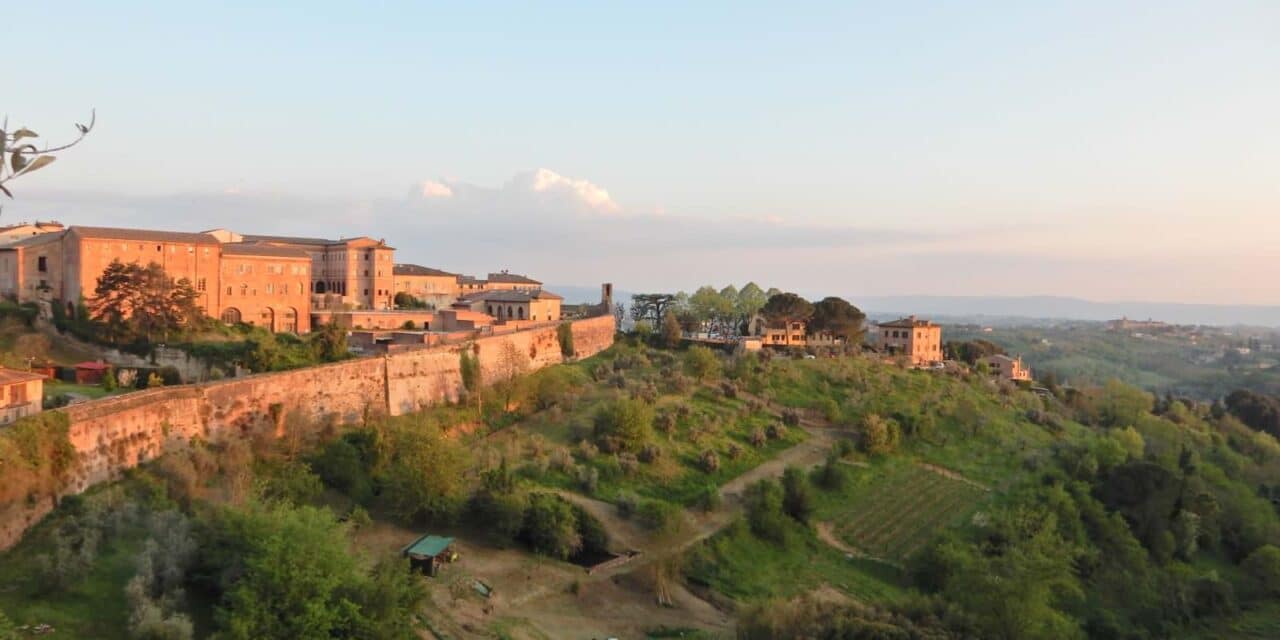
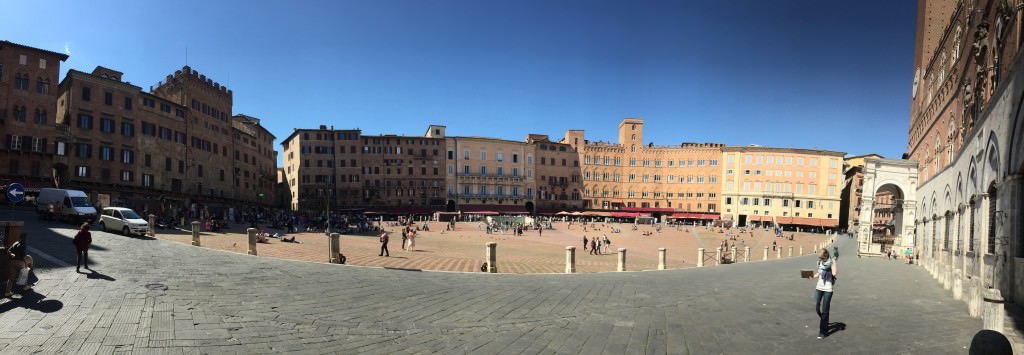
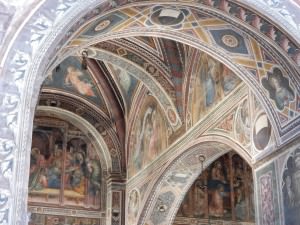

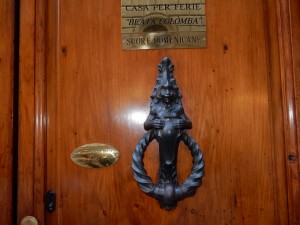
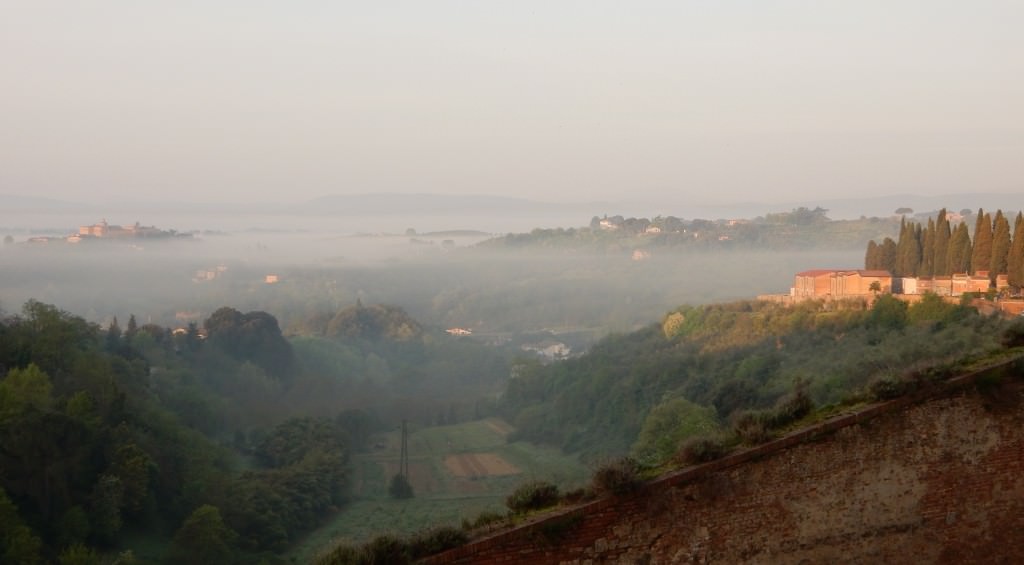
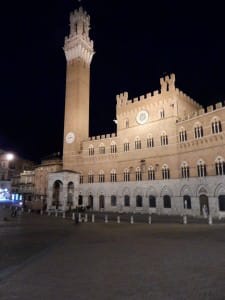

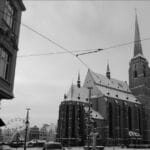



I love Italy, but have still not made it to Siena. Would love to go!!!
It is utterly lovely and the best thing was in the evenings the day-tourists disappeared (tour buses, etc) and the city was empty and elegant and explorable!
Thanks for sharing your adventures in Siena Rose! I went there on a family trip years ago and was stunned by the rustic beauty. A highlight was climbing up the Duomo Tower, although I thought I would never make it to the top. The view was worth it.
I’m impressed that you made it up the Tower! That is a lot of steps to conquer. My husband has a bum knee and I didn’t want to do it without him. But perhaps if I get to go again!
Rose, thanks for the pictorial tour of Siena – so beautiful. The painted walls of the Museo Civico are amazing and I liked the Piazza del Campo at night – looked so peaceful. Your door knockers were pretty neat too – I’m sure the third one down would have kept me away, pretty scary looking. What a marvelous time you must have had.
The door knockers could be lovely or very scary, Lenie! Yes, to the peacefulness of the Piazza del Campo in the evening–so different from throngs of people during the day time.
I was in Sienna very briefly once while I was staying in the Chianti region of Tuscany. I remember the hills because I was driving a standard transmission car, which I hadn’t done for about 20 years, and probably wore out the breaks. Your photos show what I missed while I was concentrating on not rolling down hills backwards.
Glad that my photo tour could help show you some of the sights you missed, Ken. I so admire your driving in Italy! I think those hills would intimidate me and I live in hilly Pittsburgh!
Sienna is a gorgeous city and even though it has been many years since I was last there I continue to remember it fondly.
It is gorgeous, Tim–the history and architecture suck you in and transport you to a time long ago. It’s enticing!
Siena looks so interesting and beautiful, your pictures of the sites are wonderful. Love the door knockers. Several years ago my husband and I took tons of pics of doors in Morocco and made them into a poster like you can get for some places. You could do that with your door knockers!
Isn’t it fun, Beth, that something as normal as a door or door knocker can strike our fancy and make us SEE a place? Morocco–oh, that sounds utterly exotic to me!
Siena sounds wonderful. I love the idea of paintings and frescoes everywhere. And I think I would have been taking pictures of the door knockers too. Hope I get there some day.
Donna, I thought about doing an entire blog about the door knockers. 🙂 They’re fascinating to me. If we owned a Victorian era house instead of 1980s one, I think I could talk husband into putting one on the front door!
Love your descriptions of all of the sights! It looks gorgeous!
It was lovely–in hugely different ways from the Cinque Terre–my favorite part of Italy.
I was there many years ago and loved it! These beautiful pictures brought back such lovely memories!
Glad to resurrect good memories!